![]() | - JL News: Aug 2016 (8/8/2016)
- Dietrich Bonhoeffer and Eberhard Bethge: anti-Nazi theologians and soulmates, pioneering lesbian minister Nancy Wilson retires, bearded woman saint Wilgefortis, holy fool Symeon of Emesa loved hermit John, Kuan Yin as queer Buddhist Christ figure, four women reformers honored from Seneca Falls to Selma to Stonewall, sisters Mary and Martha as lesbian couple, Russian saints Boris and George, Baroque artist Artemisia Gentileschi paints strong Biblical women.
- JL News: July 2016 (7/4/2016)
- Clergyman Robert Wood picketed for LGBT equality in Fourth of July 1965-69 Annual Reminder protests, Pulse Orlando shooting kills 49 at gay nightclub, “I first saw the rainbow flag in a church” reflection, Virgin Mary's lesbian kiss on Spanish poster,
artist Stephen Mead seeks suggestions for LGBT history series, 32 killed in UpStairs Lounge arson fire, civil rights champion / queer priest Pauli Murray, preacher Jemima reborn in 1776 as “Publick Universal Friend,” saints of Stonewall inspire LGBT justice and artists, homosexuality of Jesus explored by 18th-century philosopher Jeremy Bentham - JL News: June 2016 (6/5/2016)
- Rainbow Christ Prayer translated to 10 languages, LGBTQ Methodist protest art, Julian of Norwich, Harvey Milk, Joan of Arc, Uganda Martyrs, Madre Juana de la Cruz, Pentecost, congrats to new grads, Painter Rosa Bonheur honored “androgyne Christ,” new books.
- JL News: May 2016 (5/1/2016)
- First-ever LGBTQ religious books for children, LGBT activists murdered in Bangladesh, Biblical same-sex love in “David and Jonathan” painting by Edward Hicks, Christina Rossetti wrote Christmas carols and lesbian poetry, Day of Silence Prayer to stop bullying God's LGBTQ youth, 1992 LGBT protest at National Council of Churches, Nun Sor Juana de la Cruz who loved a countess in 17th-century Mexico City, RIP Bill Rosendahl (early supporter of LGBT Christians through TV “God Squad”), Italian translations.
- JL News: Easter/April 2016 (3/27/2016)
- Happy Easter with risen rainbow Christ, gay Passion of Christ series ends, Facebook ad rejection, Perpetua & Felicity, John Boswell, gay Centurion.
- JL News: Good Friday 2016 (3/25/2016)
- JL News Palm Sunday 2016 (3/20/2016)
- JL News: March 2016 (3/4/2016)
- Gay love stops hiding from church oppression in new music video: “Hiding” by Ray Isaac, Advocate.com covers gay Passion of Christ censorship on social media, Level Ground Fest uses art for LGBT faith dialogue, RIP queer theologian Ibrahim Farajaje, paired male saints Polyeuct and Nearchus, pioneering gay priest Malcolm Boyd, queer theologian Marcella Althaus-Reid, Valentine list of 15 ways to celebrate LGBT Christian love, Harvard minister Peter Gomes taught "scandalous gospel."
- JL News: Feb 2016 (2/4/2016)
- Saint Walatta Petros was a nun who shared a lifetime bond with a female partner in 17th-century Ethiopia, Saint Sebastian, history's queer martyrs rise for Ash Wednesday, David Bowie as queer messiah, Holocaust remembrance, Celtic saint Brigid and her female soulmate Darlughdach,gay saint of friendship Aelred, Ugandan LGBT activist David Kato, PFLAG founder Jeanne Manford, books.
- JL News: New Year's Eve / Jan 2016 (12/31/2015)
- Jesus in Love January Newsletter is out! Gay wedding of Jesus and beloved disciple John at Cana in art by Christopher Olwage, Bridge of Light ceremony honors LGBT culture on New Year's Eve, David and Jonathan, queer Epiphany.
- JL News Christmas 2015 (12/24/2015)
- Rainbow baby Jesus, queer Kwanzaa, Lazarus as beloved disciple, Ruth and Naomi, John of the Cross, Guadalupe, straight allies, new books.
- JL News Dec 2015 (12/6/2015)
- Gay Jesus appears in photo from Brazilian performance group Transeuntes, Top 25 LGBTQ books of 2015, intersex trial of Thomas(ine) Hall in colonial America, Bernardo de Hoyos' mystical same-sex marriage with Jesus, queer Nativity scenes, LGBTIQ guide to American Academy of Religion / Society of Biblical Literature annual meeting (AAR - SBL), spiritual resources for World AIDS Day, Mexico's Dance of the 41 Queers, St. Malachy of Armaugh, Advent, queer cheer for Christmas.
- JL News Nov 2015 (11/1/2015)
- New art film on St Sebastian, queer saints and homophobic violence by British artist Tony O'Connell, why we need LGBT saints, 8 new LGBT saints added, LGBT-friendly memorial for All Saints/All Souls Day
- JL News Oct 2015 (10/14/2015)
- Cosmic Christ art with LGBT symbols by Doyle Chappell, gay saints Sergius & Bacchus, Kim Davis cartoon by David Hayward, Pope’s visit has mixed messages for LGBT people, RIP pioneering gay priest John McNeill, lesbian saint Vida Dutton Scudder, historic photos for 47th anniversary of Metropolitan Community Churches, queer Francis of Assisi, LGBT martyrs (Matthew Shepard, FannyAnn Eddy, Tyler Clementi), two-spirit Native Americans bridge genders on Columbus Day, Henri Nouwen struggled with his homosexuality, Sufi poet/mystic Rumi inspired by same-sex love, Hildegard of Bingen and her beloved Richardis, good (gay?) King Wenceslas, new LGBTQ Christian books.
-
- JL News Sept 2015 (9/9/2015)
- Divine love transforms presidents Obama and Putin into gay saints in art by Jim Lyngvild, gay saint of 9/11 Mychal Judge, black gay civil rights leader Bayard Rustin, Mary’s lesbian goddess roots with Artemis, Blessed John Henry Newman’s romantic friendship with priest Ambrose St. John, Black Madonna becomes lesbian defender: Erzuli Dantor and Our Lady of Czestochowa, the Jesus kiss of medieval friar John of La Verna, love between Saints Bernard of Clairvaux and Malachy, and Christ and Krishna.
- JL News August 2015 (8/7/2015)
- Erotic gay soul explored in new books "HomoEros" and "Internal Landscapes," Christa art show, queer 1776 preacher Jemima Wilkinson reborn as Public Universal Friend, holy fool Symeon of Emesa and John, sisters Mary and Martha as lesbian couple, bearded holy woman Wilgefortis, Russian saints Boris and George, Baroque artist Artemisia Gentileschi paints strong Biblical women.
- JL News July 2015 (7/2/2015)
- Gay Vatican art tours, seminary course on queer Christ in art, UpStairs Lounge fire and poem, Pauli Murray, motorcycle blessing at gay leather bar, Uganda martyrs
- JL News June 2015 (6/4/2015)
- “Queer Icons” show LGBTQ people of color today in art by Gabriel Garcia Roman, Joan of Arc, Harvey Milk, resurrection song, Rainbow Christ Prayer, saints of Stonewall, Julian of Norwich, Rosa Bonheur, new books
- JL News May 2015-B (5/5/2015)
- New queer martyrdom book discussed by author Dominic Janes, Ethiopian eunuch, new queer Christ videos, Christina Rossetti, green LGBT theology on Earth Day, new LGBTQ Christian books, Day of Silence Prayer re anti-LGBT bullying, Madre Juana de la Cruz of Spain, Sor Juana de la Cruz of Mexico, Kuan Yin as a queer Buddhist Christ figure.
- JL News Easter/April 2015 (4/5/2015)
- Happy Easter with murals of Los Angeles, gay Passion of Christ series ends, blasphemy debate, Perpetua & Felicity, John Boswell, Esther & Vashti, gay Centurion, Adrienne Rich.
- JL News Palm Sunday 2015 (3/29/2015)
- JL News March 2015 (3/1/2015)
- Sacred gay union with Christ evoked by music of New-Age “Passion of Mark” by Christopher Flores and Adrian Ravarour, gay Jesus painting by Christopher Olwage shown in New Zealand, pioneering gay priest Malcolm Boyd dies at 91, Queer Clergy Trading Cards feature Kittredge Cherry, queer martyrs rise from the ashes on Ash Wednesday, paired saints Polyeuct and Nearchus served as Roman soldiers, queer theologian Marcella Althaus-Reid, gay black Harvard minister Peter Gomes preached "scandalous gospel,” latest LGBTQ Christian books.
- JL News Feb 2015 (2/8/2015)
- Top LGBT spiritual arts stories of 2014, Queer Clergy Trading Cards, Je Suis Charlie. queer black Jesus icon by David Hayward, Saint Sebastian, Saint Brigid and Darlughdach, Holocaust Remembrance, Beloved Disciple John the Evangelist, David Kato, and David and Jonathan.
- JL News Xmas 2014 / Jan 2015 (12/24/2014)
- Merry Christmas with minimalist Nativity scene, queer holiday cheer, Lazarus, Ruth and Naomi, Bridge of Light ceremony honors LGBT culture on New Year's Eve, three kings or three queens on Epiphany.
- JL News December 2014 (12/14/2014)
- Top 25 LGBT Christian books of 2014, LGBTIQ scholars meet at American Academy of Religion, AIDS saints Vivaldo and Bartolo, queer art showing Our Lady of Guadalupe, John of the Cross, book video for "The Passion of Christ: A Gay Vision."
- JL News November 2014 (11/20/2014)
- Alan Turing pilgrimage by artist Tony O'Connell, Mexico's Dance of the 41 Queers, Facebook censors gay Passion of Christ book, why we need LGBT saints, St. Malachy of Armaugh, LGBTIQ guide to American Academy of Religion / Society of Biblical Literature annual meeting (AAR - SBL)
- Passion Book Announcement (10/16/2014)
- JL News October 2014 (10/15/2014)
- Gay Passion of Christ book published, modern gay martyr Matthew Shepard, paired saint Sergius and Bacchus, 19th-century lesbian saint Vida Dutton Scudder, Francis of Assisi’s queer side revealed, medieval nuns Hildegard of Bingen and Richardis, Henri Nouwen struggled with his homosexuality, Africa’s lesbian martyr FannyAnn Eddy, Good (Gay?) King Wenceslas,. 1000th newsletter subscriber.
- JL News September 2014 (9/14/2014)
- Radclyffe Hall's queer Christianity in her life and 1928 novel “The Well of Loneliness.” Gay saint of 9/11 Mychal Judge, Mel White stands for LGBT justice at National Council of Churches, black gay civil rights leader Bayard Rustin, Mary’s Feast of Assumption has lesbian goddess roots, Blessed John Henry Newman’s romantic friendship with priest Ambrose St. John, Black Madonna becomes lesbian defender: Erzuli Dantor and Our Lady of Czestochowa, love between Saints Bernard of Clairvaux and Malachy, Christ and Krishna.
- JL News August 2014 (8/9/2014)
- Blessed John of La Verna (medieval Italian friar kissed by Jesus), queer Jesus poem by Louie Clay (ne Louie Crew), "Art That Dares" on Advocate.com, Mary and Martha as lesbian couple, Jacob wrestling with angel symbolizes sexuality struggles, bearded holy woman Wilgefortis, Russian saints Boris and George, Baroque artist Artemisia Gentileschi paints strong Biblical women, artist David Wojnarowicz mixed gay and Christian imagery, Holy fool Symeon of Emesa and John
- JL News July 2014 (7/9/2014)
- Rainbow Crucifix and Rainbow Madonna by Richard Stott, Rainbow Christ Prayer goes nationwide, queer 1776 preacher Jemima Wilkinson reborn as Public Universal Friend, UpStairs Lounge fire martyrs recalled in new film etc, queer saint Pauli Murray
- JL News June 2014 (6/3/2014)
- Uganda Martyrs, LGBT Pride / saints of Stonewall, Joan of Arc, religious role of gay bars described in new book "Baby You Are My Religion" by Marie Cartier
- JL News May 2014 (5/15/2014)
- Homosexuality of Jesus explored by 18th-century philosopher Jeremy Bentham, Madre Juana de la Cruz as genderbending saint of 16th-century Spain, Sacred Heart icon of bearded drag queen Conchita Wurst, Julian of Norwich celebrates "Mother Jesus," Easter photo of MCC founder Troy Perry and Jesus in Love founder Kittredge Cherry
- JL News, Easter 2014 (4/20/2014)
- JL News April 2014 (4/13/2014)
- Gay Passion of Christ series begins on Palm Sunday, mystical same-sex marriage affirmed in Renaissance art, black Jesus appears in liberating Way of the Cross, Jesus heals a centurion’s boyfriend, Kuan Yin as a queer Buddhist Christ figure, lesbian poet Adrienne Rich, LGBT Stations of the Cross by Mary Button
- JL News March 2014 (3/12/2014)
- Art museums explore queer Christian themes ("In His Own Likeness" in Florida and "Sinful Saints" in Los Angeles), remembering queer theologian Marcella Althaus-Reid, LGBT martyrs rise on Ash Wednesday, Brian Day poetry book explores "lust for the holy." Peter Gomes, Saints Polyeuct and Nearchus
- JL News Feb 2014 (2/12/2014)
- Top 10 stories of 2013, spiritual art supports Russian LGBT people during Olympics, 3 recent deaths (Robert Nugent, Otis Charles and Mark Shirilau), Saint Sebastian, Saint Brigid and Darlughdach, Holocaust Remembrance, Beloved Disciple John the Evangelist, David Kato, and David and Jonathan.
- JL News Xmas 2013 / Jan 2014 (12/24/2013)
- Christmas chant honors Christ the bridegroom: Cum ortus fuerit sol de Caelo; Some children see Him queer or gay: New rainbow version of Christmas carol "Some Children See Him," queer Nativity debate, Queer Lady of Guadalupe, Lazarus as Jesus' beloved disciple, Ruth and Naomi, John of the Cross
- JL News Dec 2013 (12/8/2013)
- Gay Israeli artist Adi Nes humanizes Bible stories, queer Advent, cartoon on how LGBT people know God loves us, mystical marriage of Bernardo de Hoyos, World AIDS Day, Harvey Milk, gay and lesbian Nativity cards, list of Christmas favorites
- JL News Nov 2013 (11/7/2013)
- Photos of same-sex kisses in church censored (Gonzalo Orquin), All Saints Day, Bible and homosexuality, lesbian saint and teacher Vida Dutton Scudder, same-sex soulmate St. Malachy of Armagh
- JL News Oct 2013 (10/7/2013)
- Sergius and Bacchus, queer creation, Francis of Assisi' queer side, Hildegard of Bingen and Richardis, Henri Nouwen's gay struggle, Rumi insipred by another man
- JL News Sept 2013 (9/12/2013)
- Gay artist Richard Stott paints "Intimacy with Christ," Saints Bernard of Clairvaux and Malachy, Proud Jesus blesses LGBT Pride parades, gay saint of 9/11 Mychal Judge, John Henry Newman and Ambrose St. John, lesbian goddess roots of Mary's Feast of the Assumption, civil rights champion Bayard Rustin, Christ and Krishna
- JL News August 2013 (8/4/2013)
- Black Madonna and lesbian defender Erzulie Dantor, gay Russian saints Boris and George, Wojnarowicz art and religion, LGBT resurrection by Mary Button, new translator at Santos Queer, bearded woman saint Wilgefortis
- JL News July 2013 (7/6/2013)
- Queer religious art list resource list: (Buddhism, Hinduism, Islam, Judaism, Paganism), UpStairs Lounge fire 40 years later, Pauli Murray (queer saint and first black woman ordained as an Episcopal priest), Saint Symeon and John (holy fool and hermit who loved each other), Jemima Wilkinson (queer preacher reborn in 1776 as “Publick Universal Friend”)
- JL News June 2013 (6/5/2013)
- Will Roscoe on Jesus and the shamanic tradition of same-sex love, cross-dressing painter Rosa Bonheur honors "androgyne Christ," Hidden Perspectives interviews Kittredge Cherry on LGBT religion, Adam and Steve welcome marriage equality, Joan of Arc, Rainbow Christ Prayer, Julian of Norwich
- JL News May 2013 (5/2/2013)
- Photos of LGBT saints today by Tony O'Connell, LGBT vs Christian cartoon by Carlos Latuff for Day Against Homophobia, LGBT Litany, Christina Rossetti, Sor Juana de la Cruz, new books
- JL News Easter / April 2013 (3/31/2013)
- Happy Easter, gay Passion of Christ series ends when Jesus rises and appears to Mary, marriage equality vigil, queer Buddhist Christ figure Kuan Yin, lesbian poet Adrienne Rich
- JL News: Palm Sunday 2013 (3/24/2013)
- Gay Passion of Christ paintings by Douglas Blanchard with text by Kittredge Cherry, LGBT Stations of the Cross by Mary Button, right-wing rants against queer Christ
- JL News Mar 2013 (3/2/2013)
- Artist Ria Brodell paints history's butch heroes, queer martyrs rise on Ash Wednesday, Polyeuct and Nearchus, Queen Esther, new books
- JL News Feb 2013 (2/9/2013)
- Top 10 LGBT spiritual arts stories of 2012, LGBT clergy at Inauguration, Saint Sebastian, Lesbian Virgin Mary poster protested in Croatia, Beloved Disciple, Holocaust Remembrance with pink triangle art, Brigid and Darlughdach, David and Jonathan, Ugandan LGBT maryr David Kato
- JL News Xmas 2012 / Jan 2013 (12/24/2012)
- Queer baby Jesus, gay Nativity in Columbia, artist Eric Martin paints naked young man from Mark's gospel, John of the Cross, ad shows Pope blessing same-sex marriage, Bridge of Light holiday for New Year
- JL News December 2012 (12/4/2012)
- Divine lesbian art by Verlena Johnson, Advent, blasphemy charges for Greek gay Jesus play, Top 20 gay Jesus books, gay King Wenceslas, mystical same-sex marriage of Bernardo de Hoyos, queer Christmas gift ideas
- JL News November 2012 (11/1/2012)
- More LGBTQ saints added for All Saints Day, LGBTQ guide to American Academy of Religion - Society of Biblical Studies meeting, Cardinal John Henry Newman loved Ambrose St. John, Angela Yarber paints portrait of Kittredge Cherry, gay martyrs Sergius & Bacchus, We Wha of Zuni, Jesus in Love's 7th anniversary
- JL News October 2012 (10/4/2012)
- Queer Saint Francis of Assisi, Henri Nouwen struggles with his homosexuality, Dr. Hildegard of Bingen loved women, Jesus in rainbow shroud, Rumi inspired by same-sex love, Leviticus and religion-based violence
- JL News September 2012 (9/3/2012)
- Tony De Carlo's art (gay saints, Adam and Steve, marriage equality), gay Christ by Latuff, gay civil-rights saint Bayard Rustin, Mary's lesbian goddess roots
- Kittredge Cherry Update, Sept 2012 (9/25/2012)
- Sample issue of KC Update, a monthly e-newsletter with timely reflections on LGBT spirituality and art plus a report on her latest activities. KC Update is available only to paid subscribers for $25 per month.
- JL News August 2012 (8/2/2012)
- Queer grace with art by Felicia Follum, marriage of Jesus and Freddie Mercury by Mr. Fish, Pauli Murray voted into sainthood, blasphemy charge from Americans for Truth, queer saints Wilgefortis, Boris & George, Artemisia Gentileschi
- July 2012 (7/1/2012)
- Queer saint for Independence Day: Jemima Wilkinson was reborn in 1776 as “Publick Universal Friend,” Rainbow Christ Prayer by Kittredge Cherry and Patrick Cheng, cartoon shows Jesus walking on dangerous waters carrying LGBT kid, my first LGBT Pride march
- June 2012 (6/6/2012)
- Stonewall paintings by Sandow Birk, Sweden's first LGBT altar by Elisbeth Ohlson Wallin, resurrection images from Gay Passion of Christ with art by Doug Blanchard and text by Kittredge Cherry, 2 new gay Jesus books, Joan of Arc, LGBT Pride prayers
- May 2012 (5/3/2012)
- Ethiopian eunuch shows early church welcomed queers, gay teen wins right to wear "Jesus is not a homophobe" shirt on Day of Silence, lesbian poet Christina Rossetti, gay Jesus makes news in the Guardian, Sor Juana de la Cruz loved a countess
- Easter 2012 (4/8/2012)
- Happy Easter with Queer Resurrection by Andrew Craig Wiliams, Gay Passion of Christ series by Douglas Blanchard ends, Queer Christ article in Huffington Post by Kittredge Cherry -- and conservative attacks on it
- April 2012 (4/1/2012)
- Gay Passion of Christ series with art by Douglas Blanchard and new text by Kittredge Cherry, gay Jesus kiss behind the scenes at "Corpus Christi," Queens Esther and Vashti, gay centurion, new queer Christ book by Patrick Cheng
- March 2012 (3/1/2012)
- Angela Yarber paints holy lesbian icons and other women, "Most Fabulous Story Ever Told" protested, executions for sodomy, closeted Jesus in "Dark Knowledge," Polyeuct and Nearchus, St. Valentine: marriage-equality role model
- February 2012 (2/3/2012)
- Top 10 LGBT spiritual arts stories of 2011, police investigate attack on gay / lesbian Nativity scene at California church, Ugandan LGBT rights activist David Kato remembered one year later, St. Brigid and her female soulmate, Kittredge Cherry starts writing for Huffington Post
- Christmas 2011 / New Years 2012 (12/24/2011)
- Christmas greetings, LGBT Nativity contest, queer saints on Huffington Post, Clinton tells UN that gay rights are human rights, Bridge of Light LGBT New Year ceremony
- December 2011 (12/7/2011)
- History's gay couples by artist Ryan Grant Long, mystical same-sex marriage of Blessed Bernardo de Hoyos and Jesus, LGBT Nativity contest, LGBTQ guide to American Academy of Religion
- November 2011 (11/1/2011)
- All Saints Day reflection on why we need LGBT saints, new LGBT spirituality resource pages, All Saints / All Souls memorial, author Hartman on gay Jesus, We'wha of Zuni (two-spirit Native American)
- October 2011 (10/7/2011)
- Sergius and Bacchus in new art, Rumi inspired by same-sex love, Tyler Clementi and bullying of LGBT youth, Hildegard of Bingen, Francis of Assisi
- September 2011 (9/10/2011)
- Gay saint of 9/11 Mychal Judge, civil-rights hero Bayard Rustin, Mary's lesbian-goddess roots with Artemis, Cardinal John Henry Newman, innovative icons.
- August 2011 (8/6/2011)
- Gay angel weeping and other art by Wes Hempel, conservatives attack our lesbian/gay Nativity scenes, same-sex marriage saints Boris and George, Artemisia Gentileschi paints strong Biblical women, Jacob wrestling, Mary Magdalene
- July 2011 (7/6/2011)
- Sensuous gay saints by artist Ted Fusby, blasphemy charges against Our Lady by Alma Lopez, John McNeill and LGBTs vs. the Vatican, reimagining God the Father.
- June 2011 (6/7/2011)
- Lady Gaga's queer spirituality, gay priest John McNeill shakes up Rome, Joan of Arc, Hunky Jesus contest, Pentecost, saints of Stonewall, LGBT pride prayers and hymns
- May 2011 (5/8/2011)
- Julian of Norwich celebrates Mother Jesus, Holocaust remembrance, Gay Passion of Christ series climax.
- Easter 2011 (4/24/2011)
- Gay Passion of Christ series (art by Douglas Blanchard, text by Kittredge Cherry), Easter videos
- April 2011 (4/8/2011)
- Gay Passion of Christ series, female Christa, queer martyrs rise from ashes
- March 2011 (3/4/2011)
- Erotic Christ interview with Hunter Flournoy, Bible's "Unprotected Texts" on sex, LGBT affirming poetry contest, Saints Polyeuct and Nearchus
- February 2011 (2/8/2011)
- Top LGBT spiritual arts stories of 2010, Uganda's gay martyr David Kato, Queer Lady of Guadalupe, Smithsonian censorship, acrobats strip for Pope
- Christmas 2010 (12/24/2010)
- December 2010 (12/2/2010)
- Rethinking Sin and Grace for LGBT People: Liberator Christ and Out Christ, LGBT Jerusalem photos, protests end queer Jesus exhibit in Spain, banned photo of gay Christ, gay King Wenceslas, Christmas video message brings hope
- November 2010 (11/1/2010)
- LGBT-friendly memorial for All Saints All Souls, It Gets Better video for LGBT youth, inclusive art built from anti-gay DVDs, LGBT church history photos, Sally Gearhart on fighting the right with love, Saints Sergius and Bacchus, blog birthday, gay and lesbian Nativity scene cards, holiday gift ideas
- October 2010 (10/4/2010)
- St. Francis with Islamic sultan and gay Jesus, church fires artist for transforming anti-gay DVD, John Henry Newman's queer path to sainthood, Dirk Vanden's gay Jesus vision, Hildegard of Bingen's love for women, pet portraits, memorial candles
- September 2010 (9/2/2010)
- Krishna and Christ, Queer disciples in the Bible, Pride photo with gay Jesus sign, women's spirituality art book by Janet McKenzie, gay saint of 9/11 Mychal Judge
- August 2010 (8/5/2010)
- Ex-gay movement as genocide, To Anne Rice: You can be pro-gay AND Christian, St. Wilgefortis (bearded woman), St. Boris and George, Mary and Martha: sisters or lesbian couple?
- July 2010 (7/9/2010)
- Queer spiritual art in Tikkun magazine, saints of Stonewall, If Jesus Were Gay poems, LGBT Pride songs and prayers, Hands around the God Box
- June 2010 (6/4/2010)
- How to unite sexuality and spirituality, Jesus has male lover in Marien Revelation, International Day Against Homophobia, transgressing gender in the Bible, spirit-centered male nudes by Peter Grahame
- May, 2010 (5/1/2010)
- Black lesbian prayers and art, gay Holocaust, Mexican nun who loved a countess (Sor Juana), Houston Chronicle gay Jesus interview, is this a sexy Jesus?
- Easter 2010 (4/4/2010)
- Happy Easter, Foreplay to Eternity prayer, Kuan Yin as androgynous spirit of compassion
- April 2010 (4/1/2010)
- GLBT Holy Week series, Sts. Perpetua and Felicity, AIDS crucifixion, Twitter
- March 2010 (3/2/2010)
- Paintings honor gay martyrs, lesbians infiltrate anti-gay church in documentary, homoerotic Jesus poems, Sts. Polyeuct & Nearchus, great sermon says "We ARE light"
- February 2010 (2/1/2010)
- Top GLBT spiritual art stories of 2009, St. Brigid & Darlughdach, blasphemy charge aids queer Jesus photo project, Epiphany, David & Jonathan, 2009 fundraising goal met
- Christmas 2009 (12/24/2009)
- Good (gay?) King Wenceslas, GLBT nativity video, Xmas excerpt from new trans Jesus play, Jesus tells Xmas story to animals, lesbian Madonna art
- JL News, Dec 2009 (12/1/2009)
- World AIDS Day, Advent, 300 protest transsexual Jesus play, Harvey Milk, Thanksgiving
- JL News, Nov 2009 (11/4/2009)
- Noah's gay wedding cruise, erotic encounter with the divine, Equality March video, transvestite Jesus, Saints Sergius and Bacchus, animal blessing, gay-friendly Jesus billboards
- JL News, Sept 2009 (9/11/2009)
- Gay saint of 9/11, National Equality March video, Jesus as lover, Mary's ecstasy, queer poem, cool new T-shirts, $185 needed, new books
- JL News, Summer 2009 (7/1/2009)
- Comic video jests about gay Jesus, Ruth and Naomi painting, "Jesus Never Married" poster, same-sex marriage not new, Eros & Christ series starts soon
- JL News, April 2009 (4/5/2009)
- Easter video with wildflowers, Gay Holy Week series, gay Passion photos by Recker, lesbian poet laureate, reflection on love and loss
- JL News, Feb 2009 (2/10/2009)
- Erotic angel art, video valentine on same-sex marriage, gay bishop prays at inauguration, Prayers for Bobby, Milk & coming out, Ted Haggard, gay Holy Week, new books & DVDs
- Special alert: AltXmasArt, Dec 2008 (12/25/2008)
- Alternative Christmas Art (all 12 images), top 5 stories of 2008.
- JL News, Dec 2008 (12/1/2008)
- Protests for same-sex marriage, AltXmasArt (alternative Christmas art), AIDS art, GLBT history, video faves based on Bible, donors honored, holiday gift idea
- JL News, Oct 2008 (10/1/2008)
- God politics art, GLBT Buddhists, lesbian folksinger, Jesus novels
- JL News, Aug 2008 (8/12/2008)
- Gay spirituality vs everybody spirituality, nursing Madonna, homoerotic Jesus T-shirt
- JL News, July 2008 (7/9/2008)
- Gay artist paints inspiring Jesus, Polish coming-out guide, gay pride march, video of 2 queer authors
- JL News, June 2008 (6/5/2008)
- Lammy Awards, funny gay Jesus music video, gay marriage stamp censored, video of Kitt Cherry on glbt Christian art, new glbt books
- JL News, May 2008 (5/3/2008)
- Austria censors gay Last Supper, Join Kitt at Lammy finalist reading 5/8, A lesbian Christian visits Israel, Art That Dares up for award, new glbt spirituality titles
- JL News, April 2008 (4/8/2008)
- Lammy finalists, Black Jesus & Obama, Kitt does reading May 8, Gay Easter bonnets, Holy Week blog, Top 5 glbt arts books
- Special Alert: Holy Week readings (3/16/2008)
- A queer version of Christ’s Passion covers Palm Sunday, the Last Supper and the 1st Easter.
- JL News, March 2008 (3/5/2008)
- Gay Mohammad art, Queer Christian art in Tikkun, Video prayer by author, Holy Week blog, At the Cross on sale
- JL News, Feb 2008 (2/4/2008)
- "At the Cross" is published, Conservatives blast Christmas card, see video of progressive spiritual fest
- JL News, Jan 2008 (1/12/2008)
- 2007's top 5 stories, Happy new year video, Queering the Last Supper, Sex & spirit mix on German book cover
- JL News, Dec 2007 (12/7/2007)
- Gay Jesus art sparks violence in Sweden, See new videos on glbt rights, Give "Art That Dares" for Christmas, New vision statement
|
|

 . Rustin states:
. Rustin states: and books such as Lost Prophet: The Life and Times of Bayard Rustin
and books such as Lost Prophet: The Life and Times of Bayard Rustin by historian John D’Emilio. The book "I Must Resist: Bayard Rustin’s Life in Letters", edited by Michael Long was a 2013 finalist for a Lambda Literary Award. A chapter on Bayard Rustin by Patricia Nell Warren is included in the 2015 book “The Right Side of History: 100 Years of LGBTQI Activism.”
by historian John D’Emilio. The book "I Must Resist: Bayard Rustin’s Life in Letters", edited by Michael Long was a 2013 finalist for a Lambda Literary Award. A chapter on Bayard Rustin by Patricia Nell Warren is included in the 2015 book “The Right Side of History: 100 Years of LGBTQI Activism.”









 by cultural historian Marina Warner shows how the figure of Mary was shaped by goddess legends and other historical circumstances, resulting in an inferior status for women.
by cultural historian Marina Warner shows how the figure of Mary was shaped by goddess legends and other historical circumstances, resulting in an inferior status for women. 



















 ” by
” by  , a novel about a young Catholic brother torn between his sexuality and his spirituality as an out and proud gay man.
, a novel about a young Catholic brother torn between his sexuality and his spirituality as an out and proud gay man. is a complete and uplifting documentary on Father Mychal’s life, including his gay orientation and his support for LGBT rights. Its producers include Brendan Fay, who directed “
is a complete and uplifting documentary on Father Mychal’s life, including his gay orientation and his support for LGBT rights. Its producers include Brendan Fay, who directed “

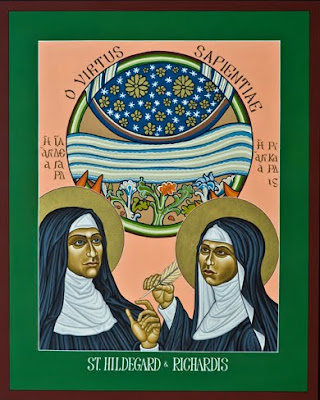
 . Von Trotta is one of the world’s most important feminist filmmakers and a leader of independent German cinema. Von Trotta allows Hildegard to speak for herself by using a script based on Hildegard’s own writings and a soundtrack filled with Hildegard’s music. Watch a
. Von Trotta is one of the world’s most important feminist filmmakers and a leader of independent German cinema. Von Trotta allows Hildegard to speak for herself by using a script based on Hildegard’s own writings and a soundtrack filled with Hildegard’s music. Watch a 




 .” Her music is still just as beautiful today.
.” Her music is still just as beautiful today. 

 .
.


 ,
,  , and
, and  .
. by Michael Ford. Despite his loneliness and same-sex attractions, there is no evidence that Nouwen ever broke his vow of celibacy.
by Michael Ford. Despite his loneliness and same-sex attractions, there is no evidence that Nouwen ever broke his vow of celibacy. 
 :
:



 .” He was silenced by the Vatican and expelled from the Jesuit order for coming out and promoting LBGT rights in church and society.
.” He was silenced by the Vatican and expelled from the Jesuit order for coming out and promoting LBGT rights in church and society.  ,” “
,” “ ,” “
,” “ ” and “
” and “ .”
.”
 .”
.”




 . It was forbidden both because of its homoerotic content and because it promotes the “blasphemy” that one must go beyond religion in order to experience God.
. It was forbidden both because of its homoerotic content and because it promotes the “blasphemy” that one must go beyond religion in order to experience God. , which has translations by Coleman Barks with John Moyne. For the whole poem, visit
, which has translations by Coleman Barks with John Moyne. For the whole poem, visit 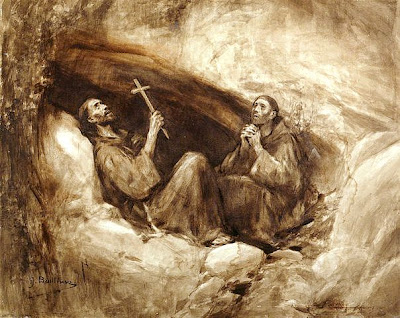

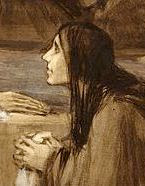
 by Thomas of Celano, a follower of Francis who knew him personally. The biography was completed by 1230, just four years after Francis died. Celano says that when Francis was in his 20s, before embracing a life of poverty, he dearly loved a special male friend:
by Thomas of Celano, a follower of Francis who knew him personally. The biography was completed by 1230, just four years after Francis died. Celano says that when Francis was in his 20s, before embracing a life of poverty, he dearly loved a special male friend:
 by Kittredge Cherry.
by Kittredge Cherry.

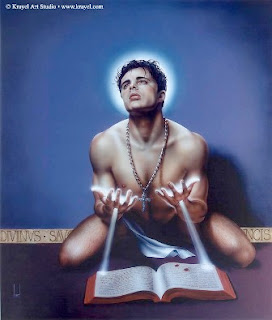















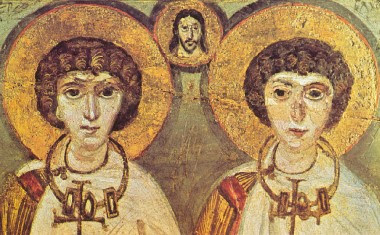
 ”. (The others are
”. (The others are 
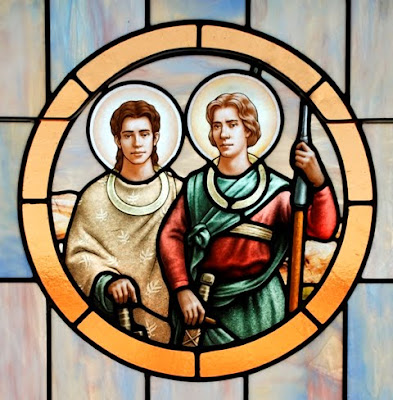
 . The book includes a chapter retelling the love story of Sergius and Bacchus with historical detail.
. The book includes a chapter retelling the love story of Sergius and Bacchus with historical detail.

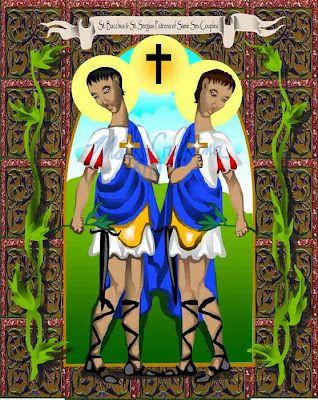

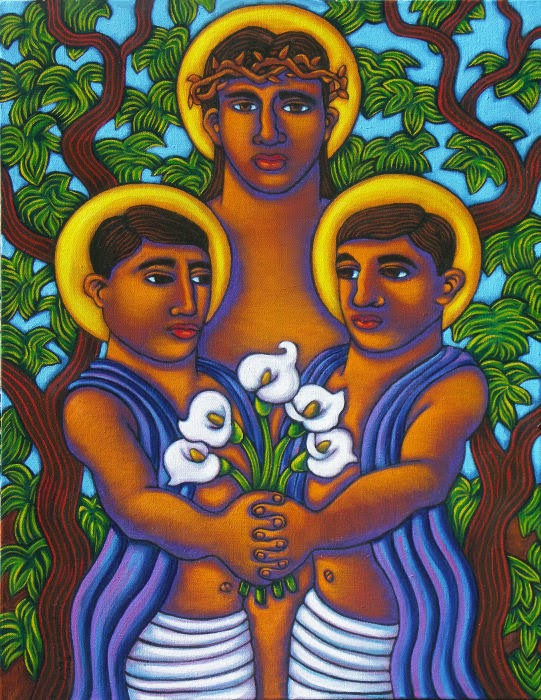



 .
.
 by Kittredge Cherry.
by Kittredge Cherry.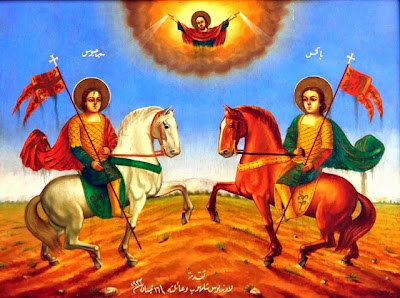











 ” by gay anthropologist Will Roscoe. He also wrote “
” by gay anthropologist Will Roscoe. He also wrote “ ” and “
” and “ .” Roscoe’s website
.” Roscoe’s website 





 ,” which he co-authored with Megan McKenna.
,” which he co-authored with Megan McKenna. 


 .” For more about Mead and his art, see my previous post “
.” For more about Mead and his art, see my previous post “
 was released in 2002.
was released in 2002. ” with Sam Waterson and Stockard Channing as the grieving parents.
” with Sam Waterson and Stockard Channing as the grieving parents.


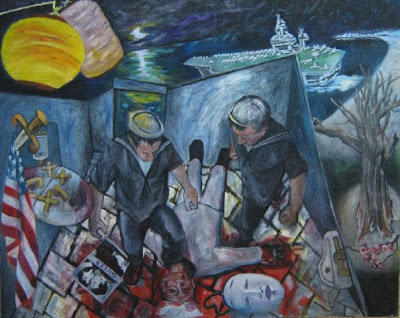

 ” tells the true story of how his mother, Dorothy Hadjys-Holman, overcame her own homophobia and Naval cover-up attempts to get justice for her gay son. She also spoke at the 1993 March on Washington for LGBT Rights.
” tells the true story of how his mother, Dorothy Hadjys-Holman, overcame her own homophobia and Naval cover-up attempts to get justice for her gay son. She also spoke at the 1993 March on Washington for LGBT Rights. 




